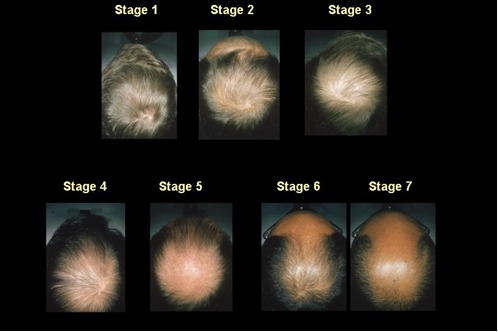• Hair loss causes significant psychosocial problems and impacts the men.
• Fall of hair up to 100 per day is a natural phenomenon, but when these hairs do not grow again because of some reason, it results in baldness.
Male pattern baldness, also called androgenic alopecia, is the most common type of hair loss in men.
Androgenic alopecia is seen in both men and women. The hair loss in men is often faster, earlier onset, and more extensive. Male Pattern Baldness is a genetic condition that can be passed down from either side of the family tree. Combination of hormones and heredity (genetics) is needed to develop the condition.
The androgens have many functions, including regulating hair growth. Each hair on your head has a growth cycle. With male pattern baldness, this growth cycle begins to weaken and the hair follicle shrinks, producing shorter and finer strands of hair. Eventually, the growth cycle for each hair ends and no new hair grows in its place.
Causes of Hair Loss /Alopecia in Men –
There are various reasons of hair fall, some important one is as follows-
• Androgenetic –
This is the most common cause of hair loss in men. Men carry genes for hair loss from either or both parents. Testosterone hormone activates the genetic sequence which is responsible for hair loss. The age of onset, rate of fall and grade of baldness also depends on some other factors and may be different in different persons.
Other causes are severe illness, Malnutrition, Vitamin deficiency, improper lifestyle, stress and pollution.

Male Pattern Hair Loss (MPHL)
Male pattern Hair loss is an inherited condition. It can be there even if Androgens level are in normal range. It is aggravated if genes for baldness are inherited from mother or father. In men who develop MPHL, the hair loss may begin any time after puberty. The severity of MPHL increases with age and is a progressive condition. The clinical appearance is typical first thinning starts, the recession of temporal area followed by hair loss in the crown.
Treatment of MPHL –
To prevent or decrease the rate of hair fall medical treatment is a must. But for a lost hair transplant is needed.
US FDA approved Medical Treatment for men is-
• Finasteride 1mg Per Day –
It prevents the effect of Hormone DHT on the hair by blocking the enzyme 5 alpha reductase. It takes a year to show its result. Side effects of finasteride are rare and reversible. For more detail you should consult your doctor.
• Minoxidil 5% –
It promotes hair growth by increasing the duration of hair follicle growth cycle (Anagen). It is most effective if applied twice a day on the scalp. It takes 6-12 months before results are visible.
• LLLT –
Low light laser therapy is also useful for hair growth. It works by photobiomodulation at the cellular level.
The FDA approval of oral finasteride and minoxidil for treatment of androgenic alopecia.